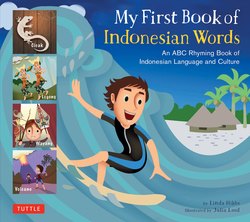Читать книгу My First Book of Indonesian Words - Linda Hibbs - Страница 6
ОглавлениеIntroduction
My First Book of Indonesian Words introduces young children to Indonesian language (called Bahasa Indonesia) and culture through simple words that are part of everyday Indonesian life. Some of the words included in this book are specific to Indonesia while others have equivalents in languages all over the world.
Indonesian language is phonetic—it is spelled how it sounds. The vowel sounds (a, e, i, o, u) are usually softer than in English words.
Vowels
A – pronounced “ah”
E – pronounced “eh”
I – pronounced “ee”
O – pronounced “oh”
U – pronounced “oo”
Consonants
C – is pronounced “ch.”
All other consonants are the same as in English.
Generally, in two-syllable words, emphasis is on the first syllable. In longer words, most emphasis is on the second-to-last syllable.
For example, in “Apa kabar?” (“How are you?”) the emphasis falls on the first syllable of both words: A pa ka bar? For words like gamelan the emphasis is as follows: ga me lan.
Some of the words chosen have direct translations in English, such as enak (delicious) and kucing (cat), while others have specific cultural meaning, for example batik (wax drawn on cloth to make designs) and dokar (a two-wheeled horse-drawn cart).
Words that start with F, X, Q and Z are not found very often in Indonesian, but some English words starting with one of these letters have been adopted into the language, for example futbal (football or soccer).
Although hundreds of languages are spoken on the many islands that make up Indonesia, the existence of this shared language makes it possible for all Indonesians to communicate with one another. Indonesian is spoken by more than 240 million people around the world. We hope that this book will help that number grow by at least one. Happy reading!
